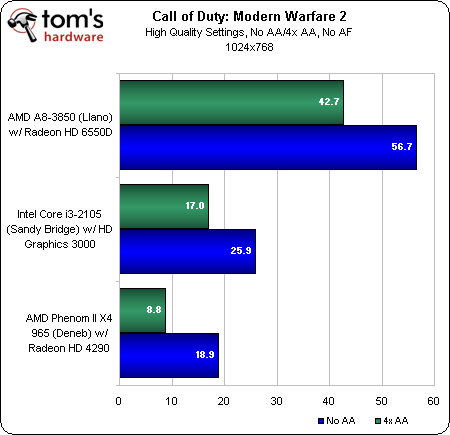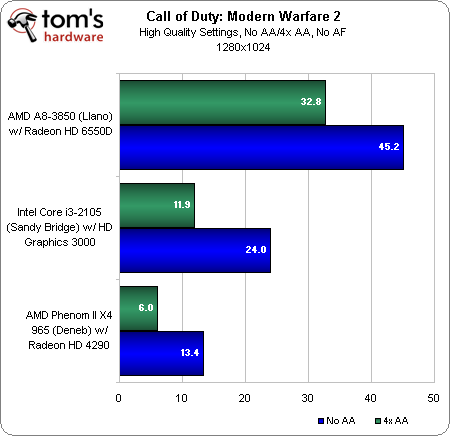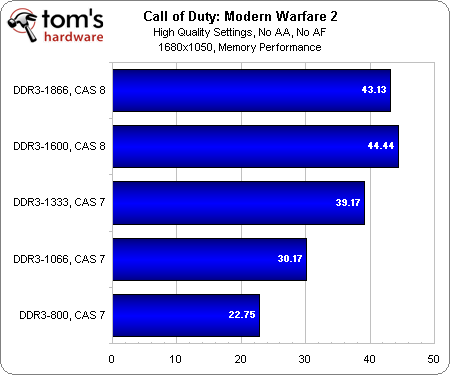AMD A8-3850 Review: Llano Rocks Entry-Level Desktops
Earlier this month we previewed AMD's Llano architecture in a notebook environment. Now we have the desktop version with a 100 W TDP. How much additional performance can the company procure with a loftier thermal ceiling and higher clocks?
Benchmark Results: Call of Duty: Modern Warfare 2 (DirectX 9)
Call of Duty, on the other hand, is playable on the A8-3850’s Radeon HD 6550D core.
At 1680x1050, the speed-up is almost 4x compared to AMD’s previous-generation integrated graphics solution. And it’s almost 2x compared to Intel’s best effort—without anti-aliasing enabled. Apply an even more taxing load using 4x AA and AMD nearly triples Intel’s frame rate.
Because Call of Duty responds so well to platform changes, our decision to standardize on DDR3-1333 does hurt the A8-3850’s numbers a bit. However, we also have the data to show what you’d get with an upgrade to memory running at a higher data rate. You’ve already seen this graph, but here it is again:
The biggest jumps happen when you switch from DDR3-800 to DDR3-1066 and then to DDR3-1333. But there’s another sizable gain in shifting to DDR3-1600, even if it means a command rate of two (from one previously).
The move to DDR3-1866 actually turns out to be detrimental because it requires relaxing a couple of other timings, even if we’re able to maintain CAS 8. The sweet spot here is definitely DDR3-1600 at the lowest latency you can get.
Get Tom's Hardware's best news and in-depth reviews, straight to your inbox.
Current page: Benchmark Results: Call of Duty: Modern Warfare 2 (DirectX 9)
Prev Page Benchmark Results: Metro 2033 (DirectX 10) Next Page Benchmark Results: World Of Warcraft: Cataclysm (DirectX 9 And 11)-
SteelCity1981 So then what's the point of getting the Turbo Core versions when they are going to be Turbo Clocked slower then the none Turbo Clocked versions...Reply -
cangelini SteelCity1981So then what's the point of getting the Turbo Core versions when they are going to be Turbo Clocked slower then the none Turbo Clocked versions...Reply
They don't want you to see better performance from a cheaper APU in single-threaded apps by pushing Turbo Core further ;-) -
Known2Bone i really wanted see some amazing gains in the content creation department what with all that gpu power on chip... oh well games are fun too!Reply -
ivan_chess I think this would be good for a young kid's PC. It would be enough to run educational software and a web browser. When he grows up to be a gamer it would be time to replace the whole machine anyway.Reply -
DjEaZy ... it's may be not the greatest APU for desktop... but it will be a powerful thingy in a laptop... the review was nice... but in the gaming department... would be nice to see a standard 15,x'' laptop resolution tests @ 1366x768... or something like that...Reply -
Mathos Actually if you want good DDR3 1600 with aggressive timings, the Ripjaws X series memory that I have does DDR3 1600 at 7-8-7-24 at 1.5v, not all that expensive when it comes down to it either.Reply -
Stardude82 This makes little sense. An Athlon II X3 445 ($75) and a HD 5570 ($60, on a good day you can get a 5670 for the same price) would provide better performance for the same price ($135) and not have to worry about the RAM you use.Reply
So is AM3+ going to be retired in favor of FM1 in the near future? Why are there chipset at all? Why isn't everything SOC by now?
Otherwise this is a very good CPU. If AMD has used 1 MB level 2 caches in their quads when they came out with the Deneb Propus die, they would be much more competitive. -
crisan_tiberiu stardude82This makes little sense. An Athlon II X3 445 ($75) and a HD 5570 ($60, on a good day you can get a 5670 for the same price) would provide better performance for the same price ($135) and not have to worry about the RAM you use. what about power consumption?Reply




